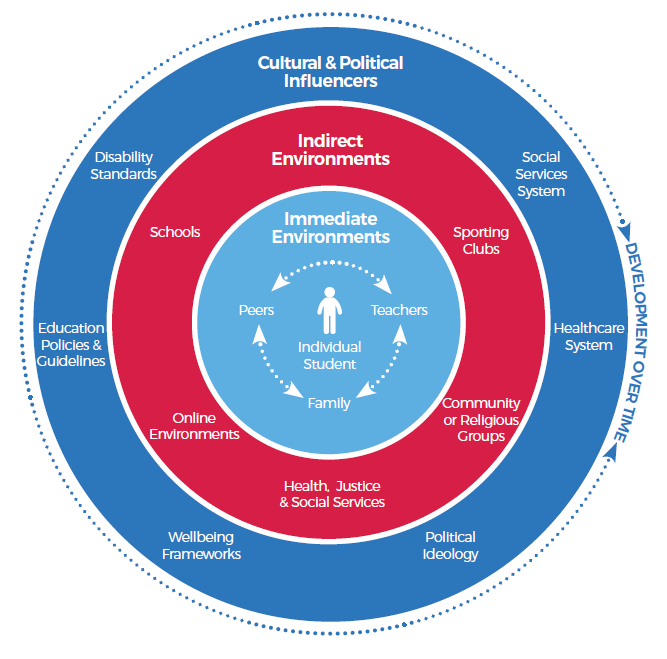Factors influencing behaviour
Family, peers, school and the wider community all impact on student behaviour, and on learning and wellbeing. The way we behave is also influenced by personal characteristics such as age, sex, personality, temperament and mental and physical health.
The following model helps us to identify how multiple environments influence our learning, wellbeing and development, and how risk and protective factors can impact. For example, risk factors, such as economic disadvantage can increase the probability that a problem will develop and persist. Protective factors, such as a supportive family and community can minimise the impact of risk factors. Some students develop along ‘normal’ trajectories despite the presence of significant risk factors. This capacity to achieve developmental milestones in the face of adversity is called ‘resilience’.
Social-ecological systems theory represented in the diagram below is useful to describe the factors influencing student behaviour and wellbeing.
Individual characteristics such as age, sex, personality, temperament, mental health, physical health and learning and support needs interact with factors in the environment. For example, how individuals respond to stress means that some people are more sensitive to their environments, regardless of whether those environments are supportive or not.
The presence of certain hormones can also affect the way we initiate and sustain social interactions, which in turn impacts on our social behaviours and attachment. Multiple factors can influence our motivation and emotional regulation, which affects things like optimism and perseverance. These biological differences influence the development of our personality and our temperament, and our ability to develop resilience.
Peers, teachers and family have a major influence on development. For example, the involvement of parents with school activities such as volunteering, doing home reading or meeting with teachers to check their child’s progress and wellbeing are all protective factors for children and young people and support learning and development.
Environments that do not directly involve the student can still impact them. Family links with social service agencies, government departments and health providers can all influence student learning and development.
The online environment can also exert an enormous influence, and a child’s experience of the online environment is influenced by how much access they have to the Internet, and the way the Internet is used at school and at home.
Cultural, political and economic factors can also influence student learning and development. For example, state and national policies and legislation, can influence education, such as:
- Australian Government Student Wellbeing Framework
- NSW Department of Education Wellbeing Framework for Schools
- NSW Department of Education School Excellence Framework.
To provide feedback on this resource, please complete the Feedback form.
